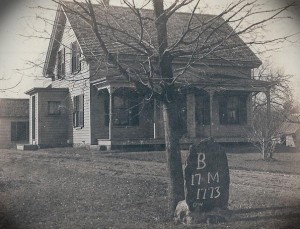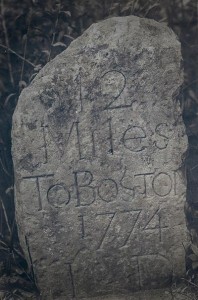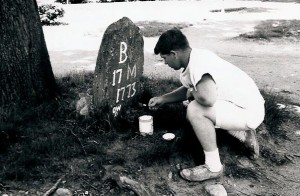True Tales from Canton’s Past: Mile by Mile
By George T. ComeauYou probably drive by them all the time without noticing. They sit by the side of the road, silent necessities of our Colonial era that are no longer needed in a modern age. The small stone mile markers, milestones, have been marking the distance from Boston since the early 1700s.

A turn of the century photograph showing the 17th milestone on Pleasant Street in front of the George Haskins House. The O.W. is the carver’s initials and below can be seen a Masonic mark. (Courtesy of the Canton Historical Society)
Today, with our satellite-guided navigation systems and global positioning devices, we are hard-pressed to get lost in our modern age. Our milestones are wonderful reminders of a distant age; they require no winding or batteries, and their warranties have long run out, but they still tell the distance to Boston and can be counted on in all types of weather.
The milestones in Canton are part of a network of stones that all lead the way to Boston. Five roads connected Boston with neighboring towns and were collectively called the Bay Roads, since they ultimately led to the Massachusetts Bay at Boston Harbor. Likely these began as Native American paths to the shore, and over time became developed cart paths and ultimately roads and highways. Our “bay road,” the Old Bay Road from Boston Bay to Taunton, extended from the earliest of settlements at Providence, Rhode Island, and the Narragansett Bay. This path was used for more than a century prior to the American Revolution and for more than 50 years thereafter. It would be the “turnpike” systems that would replace this road in the mid 1800s, but until then Bay Road was the route most preferred.
What began as a bridle path and then a cart path would become our main thoroughfare. Laid out by the selectmen of Dorchester in 1700 and again in 1712, it has had many names. In 1703 it was called the road leading to Billings’ in Sharon. In 1707 this was called the road leading to Rehoboth. Other names over the years included “Road to Rhode Island,” “The King’s Highway,” and “the great road from Boston to Taunton.” In 1840, that portion that travels through Canton between Milton and Sharon became known as Washington Street.
As the early colonists began building and improving roads, they erected mile markers to measure the distances between taverns, churches, meetinghouses, schoolhouses and blacksmiths. It was Paul Dudley, a Roxbury native educated at Harvard (class of 1690), who left an enduring legacy of milestones throughout greater Boston. From 1729 onward, Dudley erected stones measuring the distance to the then Boston Town House, now the Old State House. All of the distances on the stones, including Canton, assume a route along Washington Street in Roxbury to Eliot Square. In reality, the distances between each stone are wonderfully accurate.
At Roxbury, the town center was located at John Eliot Square, where a meetinghouse had been built in 1632. And at the fork of Roxbury and Centre streets can be found the “Parting Stone,” the terminus between the roads that lead to Boston.
For our purposes, let’s start our journey at the Milton line as we cross in front of the Blue Hills. It is here, just slightly over the Canton and Milton boundary line, that milestone 12 sits. Actually, as I began writing this story, it occurred to me that I had never actually seen this milestone. A quick detour away from the computer and out across Canton was in order.

The missing 12th milestone that was removed from Route 138 sometime in the early 1970s (Courtesy of the Canton Historical Society)
Milestone 12 was last recorded in 1950 when 22 milestone markers were carefully located and mapped after 200 years with the hope that “these milestones may still so repose after 200 more.” Locating these markers was a passion of Channing Howard, a founder of the Boston engineering firm of Whitman & Howard and an avid historian. Mr. Howard lived in Winthrop and meticulously plotted the routes and locations of the stones leading to Boston. Several letters on the topic of milestones can be found in the Canton Historical Society between Charlotte Endicott Wilde, an avid local historian, and Mr. Howard. Included in the society file are several maps showing the locations as they were found in the 1950s.
Driving over Route 128, and to your left, heading towards Blue Hill, is Milestone 13. In the cloverleaf between the exits there is a “Welcome to Canton” sign, and just next to it is the 13th mile marker placed by John Spare in 1786. Exactly one mile to the north on Route 138 should be the 12th milestone. I pulled off the road at a safe spot and walked in both directions north and south. No stone to be found. The 12th marker should be on the westerly side of the road, just at the line. Plenty of poison ivy can be found, and two private driveways. The marker is lost. Even a “trespass” behind a high stockade fence failed to yield the whereabouts of the marker. Placed here by Lemuel Davenport, this granite monument read “12 miles to Boston, 1774, L.D.” Stoughton historian Howard Hansen recalls seeing the milestone in the early 1960s; by the early 1970s the road was leveled, a hill removed and the stone disappeared. Likely this relic adorns a garden or has become a backyard conversation piece.
Turning south and continuing back into Canton, just over the bridge that crosses Route 128 (now I-93), you will again pass the John Spare milestone. Spare was the son of Samuel Spare, an early settler, who came to Stoughton in 1738. The marker was placed quite near the family home on what was known as Cherry Hill. John Spare was a member of the Stoughton Minutemen and served in the Revolutionary War.
Another mile south should yield milestone 14, and the odometer places this spot directly at the Old English Burying Ground. In front of the burying ground are two large stones with historical inscriptions detailing this site. In 1952, Mrs. Wilde, in a letter to Mr. Howard, writes, “I could not help wondering if the opposite side of [these] stones, which is wholly covered by banking and turf, might not have been the old 14 mile stone.” It may be the case that the milestone was reused in this wall, for in 1843, after many years of complaint and controversy, a new wall was erected. Granite posts, which had adorned the mansion of Gardiner Greene in Boston, were reset and iron gates were installed. Alas, the gates and any trace of milestone 14 are lost.

A youthful Ed Galvin, member of the Canton Historical Society, repaints the 17th milestone on Pleasant Street on Memorial Day 1965. (Courtesy of the Canton Historical Society)
Further south we come to milestone 15, simply marked “B 15 M” and leaning into Washington Street in front of the earliest section of St. Mary’s Cemetery. This grey ghost is easy to find and almost as easy to hit with an ill intentioned driver. Milestone 16 is reported to have been approximately where the old Endicott house stands, just before the high school. It has long been believed that this stone may very well be buried in one of the old walls that grace this section of Washington Street.
Measuring another mile, the final stone along Washington Street should by all accounts be located near the present-day Dockray and Thomas Funeral Home. Many residents, however, know that the 17th milestone is located near the falls at Shepard’s Pond in the “Hardware” section of Canton. This is our oldest stone, set here in 1736 by Nathaniel Leonard. Leonard, born in 1717, was active in the early iron business. This stone originally sat across the street and had been saved after being buried in the roadway, reset in place, and in more modern times moved by the town of Canton across the street in the small park near Pond Street. Interestingly enough, this milestone is more than three-eighths of a mile away from where a measured mile should place it. At 275 years old, it can sit wherever it wants, even if it no longer accurately measures the distance to the Old State House.
One final note to share on Canton milestones: There are three more stones that are quite curious. There is a stone at Canton Center railroad crossing measuring the distance to Providence, Rhode Island. And on Pleasant Street there are two more Boston milestones marked “B 17 M – 1773” and “B 16 M – 1773.” So, curious reader, you may be thinking, “Ah, these are the missing stones on Washington Street. Not the case, the 17th stone is Nathaniel Leonard’s near Pond Street, and no explanation has surfaced as to why the markers that follow the “Bay Road” depart up through Pleasant Street.
Channing Howard wrote in 1939 that it was his work to “rescue from threatened oblivion and preserve the story of this noble road — great in both history and romance — for those who come after. May its glory not grow dim.” To this end, every few years I go out and repaint the letters and dates on these markers. If you are so inclined to join me, I’ll have a brush and paint ready. We can all preserve our town’s history, mile by mile.
The author plans on visiting each stone on Memorial Day weekend and repainting these relics. If you would like to come along, drop an email to geocomeau@gmail.com.
Short URL: https://www.thecantoncitizen.com/?p=5212










